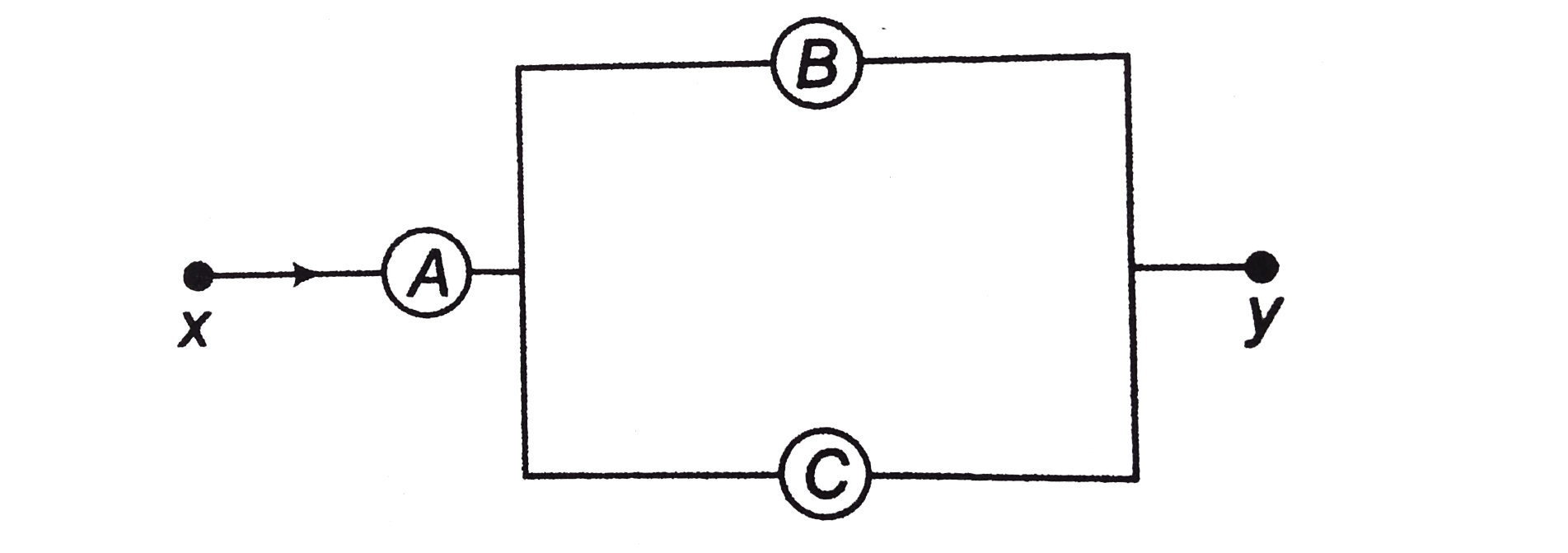The instananeous voltages at three terminals marked X,Y and Z are given by
v
VY=V0sin(ωt+2π3)andVZ=V0sin(ωt+4π3).
An ideal volmeter is configured to read rms value of the potential difference between its terminal. It is connected between points X and Y and then between Y and Z. The reading(s) of the voltmeter will be
VrmXY=V0√32
VrmXY=V0√12
VrmXY=V0
independent of the choice og the two terminals
The correct Answer is:A, D
Topper's Solved these Questions
- JEE ADVANCEDBOOK - JEE ADVANCED PREVIOUS YEARCHAPTER - JEE ADVANCEDEXERCISE - Part I : PHYSICS (Section 3)Paragraph 2
2 Videos
- JEE ADVANCEDBOOK - JEE ADVANCED PREVIOUS YEARCHAPTER - JEE ADVANCEDEXERCISE - SECTION 1
6 Videos
- JEE ADVANCEDBOOK - JEE ADVANCED PREVIOUS YEARCHAPTER - JEE ADVANCEDEXERCISE - PART I : PHYSICS (SECTION 3)
2 Videos
- JEE (ADVANCE) 2020BOOK - JEE ADVANCED PREVIOUS YEARCHAPTER - JEE (ADVANCE) 2020EXERCISE - SECTION 3
6 Videos
- JEE ADVANCED 2020BOOK - JEE ADVANCED PREVIOUS YEARCHAPTER - JEE ADVANCED 2020EXERCISE - SECTION-3
6 Videos
Similar Questions
The instantaneous voltages at three terminals marked X, Y and Z are given by
VX=V0sinωt,VY=V0sin(ωt=2π3)andVz=V0sin(ωt=4π3)
An ideal voltmeter is configured to read runs value of the potential difference between its terminals. is connected between points X and Y and then between Y and Z. The reading the voltmeter will be
View SolutionA,B and C are voltmeters of resistances R,1.5R and 3R respectively. When some potential difference is applied between x and y the voltmeter readings are VA,VBandVC, then

View Solution
Knowledge Check
The instantaneous voltages at three terminals marked X, Y and Z are given by
VX=V0sinωt,VY=V0sin(ωt=2π3)andVz=V0sin(ωt=4π3)
An ideal voltmeter is configured to read runs value of the potential difference between its terminals. is connected between points X and Y and then between Y and Z. The reading the voltmeter will beAVX=V0sinωt,Vγ=V0sin(ωt+2π3)andVZ=V0sin(ωt+4π3)BVrmsXY=V0√32CVrmsYZ=V0√12Dindpependent of the choice of the two terminalsThe instantaneous voltages at three terminals marked X, Y and Z are given by [
Vx=V0sinωt,
VY=V0sin(ωt+2π3) and
VZ=V0sin(ωt+4π3)
An ideal voltmeter is configured to read rms value of the potential difference between its terminals. It is connected between points X and Y and then between Y and Z. The reading(s) of the voltmeter will beAindependent of the choice of the two terminalsBVrmsxy=V0CVrmsyz=V0√12DVrmsxy=V0√32A,B and C are voltmeters of resistances R,1.5R and 3R respectively. When some potential difference is applied between x and y the voltmeter readings are VA,V_BandV_C, then
 AVA=VB=VCBVA≠VB=VCCVA=VB≡VCDVA+VB=VC
AVA=VB=VCBVA≠VB=VCCVA=VB≡VCDVA+VB=VC
A,B and C are voltmeters of resistances R,1.5R and 3R respectively. When some potential difference is applied between x and y the voltmeter readings are VA,V_BandV_C, then

View SolutionA,B and C are voltmeters of resistances R,1.5R and 3R respectively. When some potential difference is applied between x and y the voltmeter readings are VA,V_BandV_C, then

View SolutionA,B and C are voltmeters of resistances R,1.5R and 3R respectively. When some potential difference is applied between x and y the voltmeter readings are VA,V_BandV_C, then

View SolutionIn the circuit shown in the Figure, the voltage across resistance R, box A and box B are represented as
vR=vsin(ωt),vA=√2Vsin(ωt+π4)and
vB=vsin(ωt+π2)Find the phase difference between current and the applied voltage.

View SolutionStandard electrode potential of three metals x , y and z are - 1. 2 v,+0.5v and - 3 .0 v . The reducing power of these metals will be
View Solution
